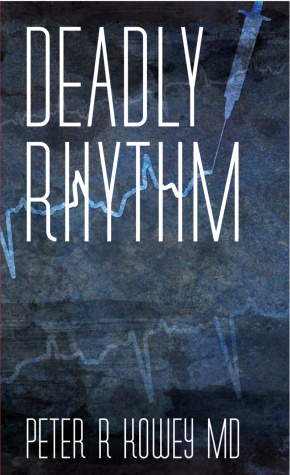Deadly Rhythm (2012)
Al Romanzo is a World War II veteran living out his days in a nursing home in the coal- mining region of northeastern Pennsylvania. A nasty fall prompts an admission to a Scranton hospital where, a few days later, he dies after an unexpected cardiac arrest. His two children, who had abandoned him years earlier upon leaving for Southern California, decide to bring a malpractice claim against his doctors. Dr. Paul Wilson, the defendant cardiologist, requests a case review by Dr. Philip Sarkis, a brilliant academic who lost his career, his family, and nearly his sanity in a messy malpractice case years before. Philip now lives on a lake in the Pocono Mountains with attorney Dorothy Deaver and their two Portuguese water dogs. He’s practicing medicine in a humble outpatient clinic, looking for ways to make some money and restore his psyche.
With the help of his lover and attorney Dorothy and her private detective father, Dick, Philip dives into the case and comes to believe that Al’s death may not have been what it seemed. In fact, Philip and Dorothy are horrified to find that dozens of old German and Italian men in the region, including a childhood friend of Philip’s, have died in other hospitals in the region under remarkably similar circumstances. As the three begin to uncover a murder conspiracy, they are intimidated and even attacked until some familiar friends enter the scene.
Deadly Rhythm is a sequel to Lethal Rhythm. Both books are fictionalized versions of real malpractice cases in which I participated as an expert witness. I wrote these stories to entertain, but also to help make the public aware of the extremely negative effect the American tort system has had on medical care. Doctors who have been sued practice defensively, willing to do whatever is necessary to avoid another courtroom appearance. Even worse, the vast majority of harmed patients and their families are not properly compensated, nor does the tort system provide the resolution of conflict that doctors and patients seek and deserve.
My fervent hope is that these novels will motivate us to find a better solution for patients and families who have been harmed by a medical error.
Lethal Rhythm (2011)
Philip Sarkis was a good doctor—maybe a little too good. So when he is sued for malpractice after a young patient dies suddenly and unexpectedly, he sinks into an alcoholic depression, losing his family and his career. With the help of two remarkable women attorneys, Sarkis discovers some astonishing things about his patient, her husband and his diabolical mistress, and himself.
We wrote LETHAL RHYTHM to help the public understand the extreme harm the current tort system has visited upon medical care. Doctors who have been sued or who have seen their colleagues collapse under the weight of litigation, approach their patients differently—if they remain in medicine at all. Our hope is that this book will stimulate change in the malpractice system for the good of the profession, and most importantly, for our patients.


